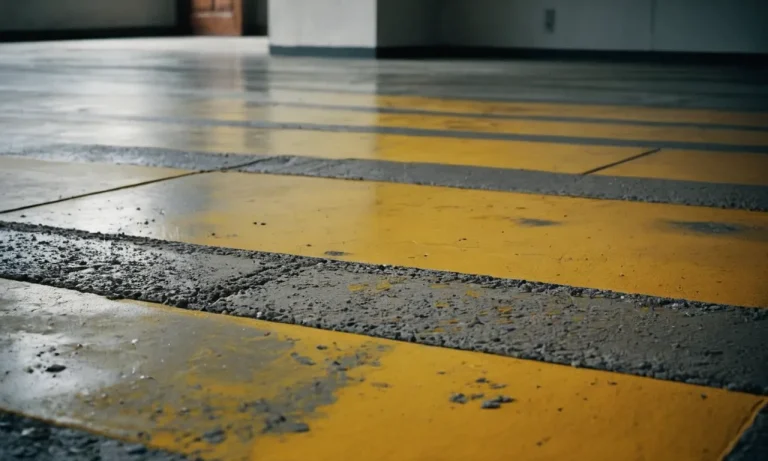How To Get Up From The Floor: A Step-By-Step Guide
Getting up from the floor can be quite challenging, especially as we get older. However, with some helpful techniques and aids, it is possible to get back on your feet safely and independently.
If you’re short on time, here’s a quick answer to your question: Use furniture or walls for support. Roll onto your side first before pushing up with your arms. Avoid twisting your spine during the process. Use leg power as much as possible.
In this comprehensive guide, we will cover various methods to help you get up from the floor. We will provide step-by-step instructions for different scenarios, along with tips for building strength and balance to make getting up easier.
Assessing the Situation Before Attempting to Get Up
Before attempting to get up from the floor, it is crucial to assess the situation to ensure your safety and avoid further injury. Taking a few moments to evaluate the circumstances can make a significant difference in your ability to get up safely and without any complications.
Check for injuries
The first step in assessing the situation is to check for any injuries you may have sustained. It is essential to be aware of any pain, discomfort, or limitations you may be experiencing. If you suspect a serious injury, it is best to stay still and wait for medical assistance.
However, if you are confident that you can safely get up, proceed with caution.
Clear space around you
Once you have determined that you are not seriously injured, the next step is to clear the space around you. Remove any objects or obstacles that may hinder your movement or cause you to trip. This will ensure a clear path for you to get up without any obstructions.
It is also important to make sure that the floor is free from any slippery or uneven surfaces that could pose a risk.
Call for help if needed
If you find yourself in a situation where you are unable to get up on your own or feel uncertain about your ability to do so safely, do not hesitate to call for help. Reach out to a family member, friend, or neighbor who can assist you.
Additionally, if you have a medical alert system or a caregiver, utilize those resources to ensure you receive the help you need.
Remember, assessing the situation before attempting to get up is crucial for your safety. By checking for injuries, clearing the space around you, and calling for help if needed, you can ensure a smooth and safe transition from the floor to your feet.
Techniques for Getting Up from the Floor
Roll onto your side first
When trying to get up from the floor, it’s important to start by rolling onto your side. This helps to protect your back and neck from strain. By rolling onto your side, you can then gradually push yourself up into a sitting position. Remember to take your time and listen to your body’s limits.
Use furniture or walls
If you find it difficult to get up from the floor using your own strength, don’t worry! You can utilize the help of nearby furniture or walls. By placing your hands on a sturdy piece of furniture or pushing against a wall, you can use these external supports to assist you in standing up.
This can be especially useful if you have limited mobility or strength.
Push up to high kneel
Another technique to get up from the floor is by pushing up to a high kneel position. Start by kneeling on both knees, then use your hands to push up and bring one foot forward. Once in the high kneel position, you can then use your leg muscles to stand up fully.
This technique can be effective for individuals with good upper body strength.
Crawl to a stable object
If you are unable to get up from the floor using the previous techniques, crawling to a stable object can be a helpful alternative. Find a nearby piece of furniture or a stable object that you can hold onto for support. Then, slowly crawl towards it, using your hands and knees.
Once you reach the object, you can use it to pull yourself up into a standing position.
Sit back technique
The sit back technique is a useful method for individuals who have difficulty with balance or strength. Start by sitting on the floor with your legs stretched out in front of you. Then, place your hands on the floor behind you, fingers pointing towards your body.
Lean back onto your hands while bending your knees and bring one foot closer to your body. Push through your hands and lift your hips off the floor, bringing the other foot closer as well. Finally, push through your hands and bring your body up into a standing position.
Remember, these techniques may vary in effectiveness depending on individual circumstances, such as age, strength, and mobility. It’s essential to consult with a healthcare professional or physical therapist for personalized advice and guidance.
Special Considerations for Different Scenarios
Getting up after a fall
When trying to get up after a fall, it’s important to stay calm and assess your body for any injuries. Take a moment to catch your breath and gather your thoughts. Slowly roll onto your side and use your arms to push yourself up into a seated position.
From there, you can gradually work your way up to standing by using nearby furniture or objects for support. Remember to take your time and listen to your body, as rushing the process could lead to further injuries.
Getting up with mobility aids
If you use mobility aids such as a walker or cane, getting up from the floor may require some additional steps. Firstly, make sure your mobility aid is within reach before attempting to get up. Use your upper body strength to lift yourself onto your knees, and then use your mobility aid to assist you in standing up.
It’s always a good idea to practice these movements with a healthcare professional to ensure you are using your mobility aid correctly and safely.
Getting up with injuries or illnesses
If you have sustained injuries or are dealing with illnesses that affect your mobility, getting up from the floor can be more challenging. In these cases, it is best to call for assistance from a caregiver, family member, or healthcare professional.
They will be able to provide the necessary support and guidance to ensure you get up safely without causing further harm. Remember, it’s important to prioritize your health and seek help when needed.
Building Strength and Balance for Getting Up
Leg strengthening exercises
Having strong leg muscles is crucial for getting up from the floor. Incorporating leg strengthening exercises into your routine can greatly improve your ability to rise easily and confidently. Squats, lunges, and leg presses are all excellent exercises that target the muscles in your lower body.
These exercises help to build strength in your quads, hamstrings, and glutes, which are essential for standing up from a seated or kneeling position. Aim to perform these exercises at least two to three times a week to see significant improvements in your leg strength.
Core and upper body exercises
While leg strength is important, having a strong core and upper body is also essential for getting up from the floor. Engaging your core muscles and strengthening your upper body can provide the stability and power needed for a smooth transition from the floor to a standing position.
Planks, push-ups, and seated rows are all effective exercises that target your core, chest, back, and arms. By incorporating these exercises into your workout routine, you can improve your overall strength and make getting up from the floor much easier.
Balance training
Good balance is key to maintaining stability while getting up from the floor. Balance training exercises can help you improve your stability and reduce the risk of falls. Yoga, tai chi, and single-leg standing exercises are all great options for improving balance.
These exercises challenge your balance and proprioception, helping you develop better control over your body’s movements. By including balance training in your fitness routine, you can enhance your ability to get up from the floor with ease.
Flexibility exercises
Flexibility plays a vital role in getting up from the floor. Stretching exercises can improve your range of motion and make it easier to maneuver into a standing position. Incorporate stretches for your hips, hamstrings, and lower back into your daily routine to increase flexibility in these areas.
Stretching after a workout or before getting up from the floor can help loosen tight muscles and make the process smoother. By maintaining good flexibility, you can enhance your mobility and make getting up from the floor a breeze.
Remember, it’s important to consult with a healthcare professional or a certified trainer before starting any new exercise program. They can assess your current fitness level and provide recommendations tailored to your specific needs.
With consistent practice and dedication, you can build strength, balance, and flexibility to make getting up from the floor an effortless task.
Using Aids and Adaptive Equipment
Getting up from the floor can be challenging, especially for individuals with limited mobility or strength. Fortunately, there are aids and adaptive equipment available to assist in this process. These tools can provide the necessary support and stability to make getting up easier and safer.
Here are some commonly used aids and adaptive equipment:
Grab bars and handles
Grab bars and handles are fixtures that can be installed on walls or furniture near the floor to provide support and leverage. They can be especially helpful in bathrooms, where falls are more common. By gripping onto a sturdy grab bar or handle, individuals can pull themselves up from the floor with less effort and reduce the risk of further injury.
Make sure to install grab bars securely, following the manufacturer’s instructions, for maximum effectiveness.
Mobility aids
Mobility aids such as canes, walkers, and rollators can also be useful in getting up from the floor. These devices provide stability and support while standing and can be leaned on to assist in the process of getting up.
Additionally, some mobility aids have built-in features like seat cushions or padded handles, which can provide extra comfort and assistance when getting up from the floor. It’s important to choose the right mobility aid that suits your needs and consult with a healthcare professional if necessary.
Fall detectors and medical alert systems
Fall detectors and medical alert systems are advanced technologies designed to detect falls and automatically alert emergency services or designated caregivers. These systems often come with wearable devices, such as pendants or wristbands, that can be activated in case of a fall or emergency.
Having a fall detector or medical alert system can provide peace of mind, knowing that help will be on the way quickly if needed. Research different options available and choose a system that meets your specific requirements and budget.
It’s important to note that while aids and adaptive equipment can greatly assist in the process of getting up from the floor, it’s always recommended to prioritize safety and seek assistance when necessary.
If you’re unsure about using a particular aid or equipment, consult with a healthcare professional or occupational therapist who can provide guidance and recommendations based on your individual needs and abilities.
Conclusion
Getting up from the floor can be difficult, but is an important skill to maintain mobility and independence. With some practice using proper technique, building strength and balance, and utilizing aids when needed, you can get yourself up safely. Don’t be afraid to ask for help when needed.
Stay active and keep moving to make getting up from the floor easier for years to come.







